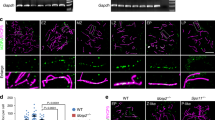Abstract.
The ATR (ataxia telangiectasia- and RAD3-related) protein is present on meiotic prophase chromosome cores and paired cores (synaptonemal complexes, SCs). Its striking characteristic is that the protein forms dense aggregates on the cores and SCs of the last chromosomes to pair at the zygotene-pachytene transition. It would appear that the ATR protein either signals delays in pairing or it is directly involved in the completion of the pairing phase. Atm-deficient spermatocytes, which are defective in the chromosome pairing phase, accumulate large amounts of ATR. The behaviour of ATR at meiotic prophase sets it apart from the distribution of the RAD51/DMC1 recombinase complex and our electron microscope observations confirm that they do not co-localize. We failed to detect ATM in association with cores/SCs and we have reported elsewhere that RAD1 protein does not co-localize with DMC1 foci. The expectation that putative DNA-damage checkpoint proteins, ATR, ATM and RAD1, are associated with RAD51/DMC1 recombination sites where DNA breaks are expected to be present, is therefore not supported by our observations.
Similar content being viewed by others
Author information
Authors and Affiliations
Additional information
Received: 23 November 1998 / Accepted: 3 January 1999
Rights and permissions
About this article
Cite this article
Moens, P., Tarsounas, M., Morita, T. et al. The association of ATR protein with mouse meiotic chromosome cores. Chromosoma 108, 95–102 (1999). https://doi.org/10.1007/s004120050356
Issue Date:
DOI: https://doi.org/10.1007/s004120050356




